FluentCMS 0.2.6
See the version list below for details.
dotnet add package FluentCMS --version 0.2.6
NuGet\Install-Package FluentCMS -Version 0.2.6
<PackageReference Include="FluentCMS" Version="0.2.6" />
paket add FluentCMS --version 0.2.6
#r "nuget: FluentCMS, 0.2.6"
// Install FluentCMS as a Cake Addin #addin nuget:?package=FluentCMS&version=0.2.6 // Install FluentCMS as a Cake Tool #tool nuget:?package=FluentCMS&version=0.2.6
FluentCMS - CRUD (Create, Read, Update, Delete) for any entities
Welcome to Fluent CMS!
If you'd like to contribute to the project, please check out our CONTRIBUTING guide.Don’t forget to give us a star ⭐ if you find Fluent CMS helpful!
What is it
Fluent CMS is an open-source Content Management System designed to streamline web development workflows.
It proves valuable even for non-CMS projects by eliminating the need for tedious CRUD API and page development.
- CRUD: Fluent CMS offers built-in RESTful CRUD (Create, Read, Update, Delete) APIs along with an Admin Panel that supports a wide range of input types, including datetime, dropdown, image, and rich text, all configurable to suit your needs.
- GraphQL-style Query Retrieve multiple related entities in a single call, enhancing security, performance, and flexibility on the client side.
- Drag and Drop Web Page Designer: Leveraging Grapes.js and HandleBars, the page designer allows you to create pages and bind query data without coding.
- Permission Control Assign read/write, read-only, access to entities based on user roles or individual permissions.
- Integration and extension Fluent CMS can be integrated into projects via a NuGet package.
Validation logic can be implemented using C# statements through DynamicExpresso, and complex functionalities can be extended using CRUD Hook Functions. Additionally, Fluent CMS supports message brokers like Kafka for CRUD operations. - Performance: Utilizing SqlKata and Dapper, Fluent CMS achieves performance levels comparable to manually written RESTful APIs using Entity Framework Core. Performance benchmarks include comparisons against Strapi and Entity Framework.
Live Demo - A online course website based on Fluent CMS
source code Example Blog Project.
- Admin Panel https://fluent-cms-admin.azurewebsites.net/admin
- Email:
admin@cms.com - Password:
Admin1!
- Email:
- Public Site : https://fluent-cms-admin.azurewebsites.net/
Adding Fluent CMS to your own project
<details> <summary> The following chapter will guid you through add Fluent CMS to your own project by adding a nuget package. </summary>
Create your own Asp.net Core WebApplication.
Add FluentCMS package
dotnet add package FluentCMSModify Program.cs, add the following line before builder.Build(), the input parameter is the connection string of database.
builder.AddSqliteCms("Data Source=cms.db"); var app = builder.Build();Currently FluentCMS support
AddSqliteCms,AddSqlServerCms,AddPostgresCMS.Add the following line After builder.Build()
await app.UseCmsAsync();this function bootstrap router, initialize Fluent CMS schema table
When the web server is up and running, you can access Admin Panel by url /admin, you can access Schema builder by url /schema.
The example project can be found at Example Project.
</details>
Developing backend of a simple online course system use Fluent CMS
<details>
<summary>
The following chapter will guide you through developing a simple online course system, starts with three entity Teachers, Courses, and Students.
</summary>
Database Schema
1. Teachers Table
This table stores information about the teachers.
| Column Name | Data Type | Description |
|---|---|---|
Id |
INT |
Primary Key, unique ID for each teacher. |
FirstName |
VARCHAR |
Teacher's first name. |
LastName |
VARCHAR |
Teacher's last name. |
Email |
VARCHAR |
Teacher's email address. |
PhoneNumber |
VARCHAR |
Teacher's contact number. |
2. Courses Table
This table stores information about the courses.
| Column Name | Data Type | Description |
|---|---|---|
Id |
INT |
Primary Key, unique ID for each course. |
CourseName |
VARCHAR |
Name of the course. |
Description |
TEXT |
Brief description of the course. |
TeacherId |
INT |
Foreign Key, references TeacherId in the Teachers table. |
3. Students Table
This table stores information about the students.
| Column Name | Data Type | Description |
|---|---|---|
Id |
INT |
Primary Key, unique ID for each student. |
FirstName |
VARCHAR |
Student's first name. |
LastName |
VARCHAR |
Student's last name. |
Email |
VARCHAR |
Student's email address. |
EnrollmentDate |
DATE |
Date when the student enrolled. |
4. Enrollments Table (Junction Table)
This table manages the many-to-many relationship between Students and Courses, since a student can enroll in multiple courses, and a course can have multiple students.
| Column Name | Data Type | Description |
|---|---|---|
EnrollmentId |
INT |
Primary Key, unique ID for each enrollment. |
StudentId |
INT |
Foreign Key, references StudentId in the Students table. |
CourseId |
INT |
Foreign Key, references CourseId in the Courses table. |
Relationships:
- Teachers to Courses: One-to-Many (A teacher can teach multiple courses, but a course is taught by only one teacher).
- Students to Courses: Many-to-Many (A student can enroll in multiple courses, and each course can have multiple students).
Build Schema use Fluent CMS Schema builder
After starting your ASP.NET Core application, you will find a menu item labeled "Schema Builder" on the application's home page.
In the Schema Builder, you can add entities such as "Teacher" and "Student."
When adding the "Course" entity, start by adding basic attributes like "Name" and "Description." You can then define relationships by adding attributes as follows:
Teacher Attribute:
Configure it with the following settings:{ "DataType": "Int", "Field": "teacher", "Header": "Teacher", "InList": true, "InDetail": true, "IsDefault": false, "Type": "lookup", "Options": "teacher" }Students Attribute:
Configure it with these settings:{ "DataType": "Na", "Field": "students", "Header": "Students", "InList": false, "InDetail": true, "IsDefault": false, "Type": "crosstable", "Options": "student" }
With these configurations, your minimal viable product is ready to use. </details>
Adding your own business logics
<details> <summary> The following chapter will guide you through add your own business logic by add validation logic, hook functions, and produce events to Kafka. </summary>
Add validation logic using simple c# express
Simple C# logic
You can add simple c# expression to Validation Rule of attributes, the expression is supported by Dynamic Expresso.
For example, you can add simple expression like name != null.
You can also add Validation Error Message, the end user can see this message if validate fail.
Regular Expression Support
Dynamic Expresso supports regex, for example you can write Validation Rule Regex.IsMatch(email, "^[a-zA-Z0-9_.+-]+@[a-zA-Z0-9-]+\\.[a-zA-Z0-9-.]+$").
Because Dyamic Expresso doesn't support Verbatim String, you have to escape \.
Extent functionality by add Hook functions
You need to add your own Business logic, for examples, you want to verify if the email and phone number of entity teacher is valid.
you can register a cook function before insert or update teacher
var registry = app.GetHookRegistry();
registry.EntityPreAdd.Register("teacher", args =>
{
VerifyTeacher(args.RefRecord);
return args;
});
registry.EntityPreUpdate.Register("teacher", args =>
{
VerifyTeacher(args.RefRecord);
return args;
});
Produce Events to Event Broker(e.g.Kafka)
You can also choose produce events to Event Broker(e.g.Kafka), so Consumer Application function can implement business logic in a async manner.
The producing event functionality is implemented by adding hook functions behind the scene, to enable this functionality, you need add two line of code,
builder.AddKafkaMessageProducer("localhost:9092"); and app.RegisterMessageProducerHook().
builder.AddSqliteCms("Data Source=cmsapp.db").PrintVersion();
builder.AddKafkaMessageProducer("localhost:9092");
var app = builder.Build();
await app.UseCmsAsync(false);
app.RegisterMessageProducerHook();
</details>
Permissions Control
<details> <summary>FluentCMS authorizes access to each entity by using role-based permissions and custom policies that control user actions like create, read, update, and delete.</summary>
Fluent CMS' permission control module is decoupled from the Content Management module, allowing you to implement your own permission logic or forgo permission control entirely. The built-in permission control in Fluent CMS offers four privilege types for each entity:
- ReadWrite: Full access to read and write.
- RestrictedReadWrite: Users can only modify records they have created.
- Readonly: View-only access.
- RestrictedReadonly: Users can only view records they have created.
Additionally, Fluent CMS supports custom roles, where a user's privileges are a combination of their individual entity privileges and the privileges assigned to their role.
To enable fluentCMS' build-in permission control feature, add the following line .
//add fluent cms' permission control service
builder.Services.AddDbContext<AppDbContext>(options => options.UseSqlite(connectionString));
builder.AddCmsAuth<IdentityUser, IdentityRole, AppDbContext>();
And add the follow line after app was built if you want to add a default user.
InvalidParamExceptionFactory.CheckResult(await app.EnsureCmsUser("sadmin@cms.com", "Admin1!", [Roles.Sa]));
Behind the scene, fluentCMS leverage the hook mechanism. </details>
Designing Queries in FluentCMS
<details> <summary> FluentCMS streamlines frontend development with support for GraphQL-style queries. </summary>
Requirements
1. Retrieve all related data with one API call
As shown in the screenshot below, we aim to design a course detail page. In addition to displaying basic course information, the page should also show related entity data, such as:
- Teacher's bio and skills
- Course-related materials, such as videos

2. Filter data by related entity
In the example below, when displaying a skill, we want to show which teachers have that skill and the courses they teach.
The tables involved include courses, teachers, teacher-skill (the cross referencing table), and skills.
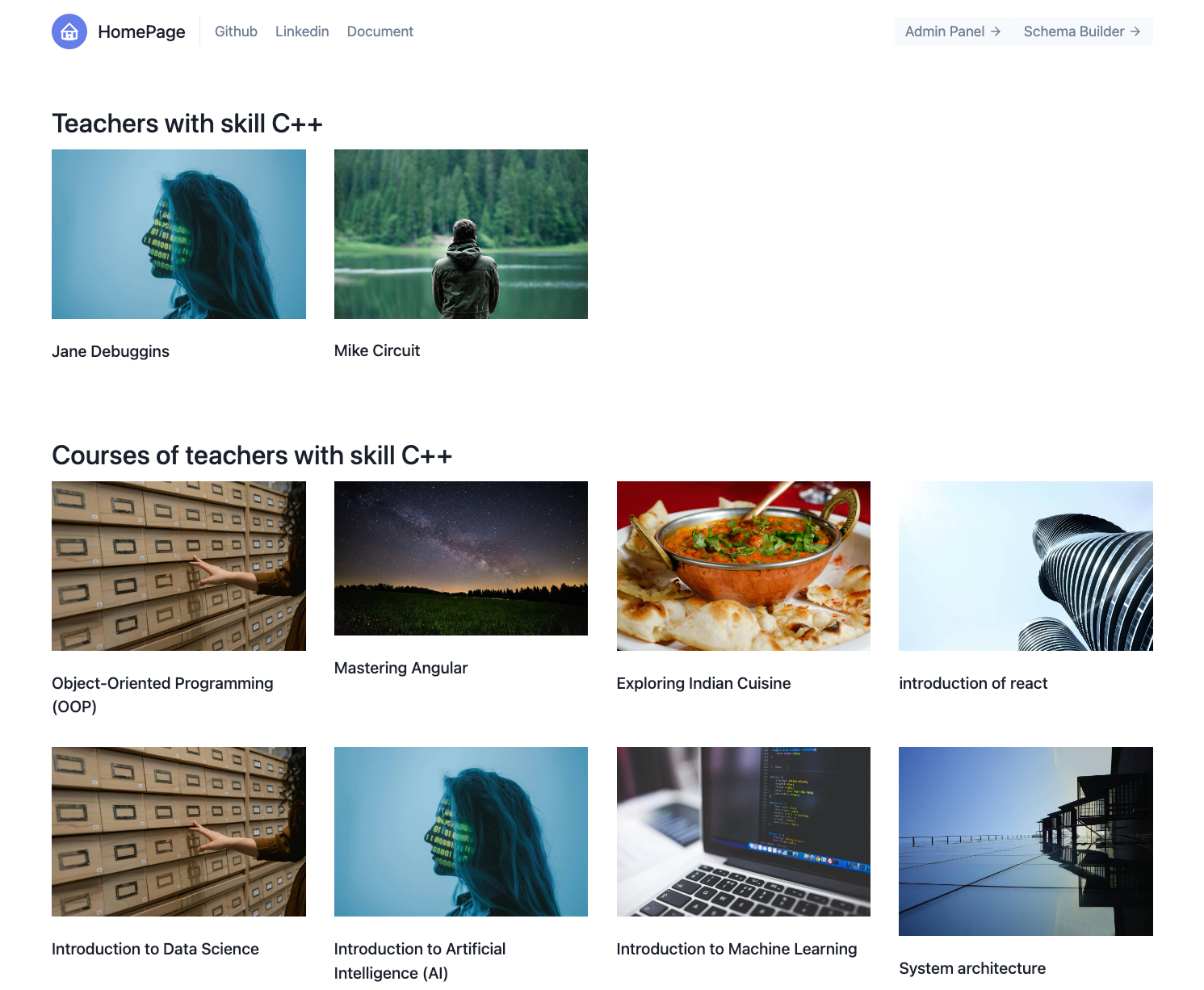
Query Settings
To create or edit a query, navigate to Schema Builder > Queries.
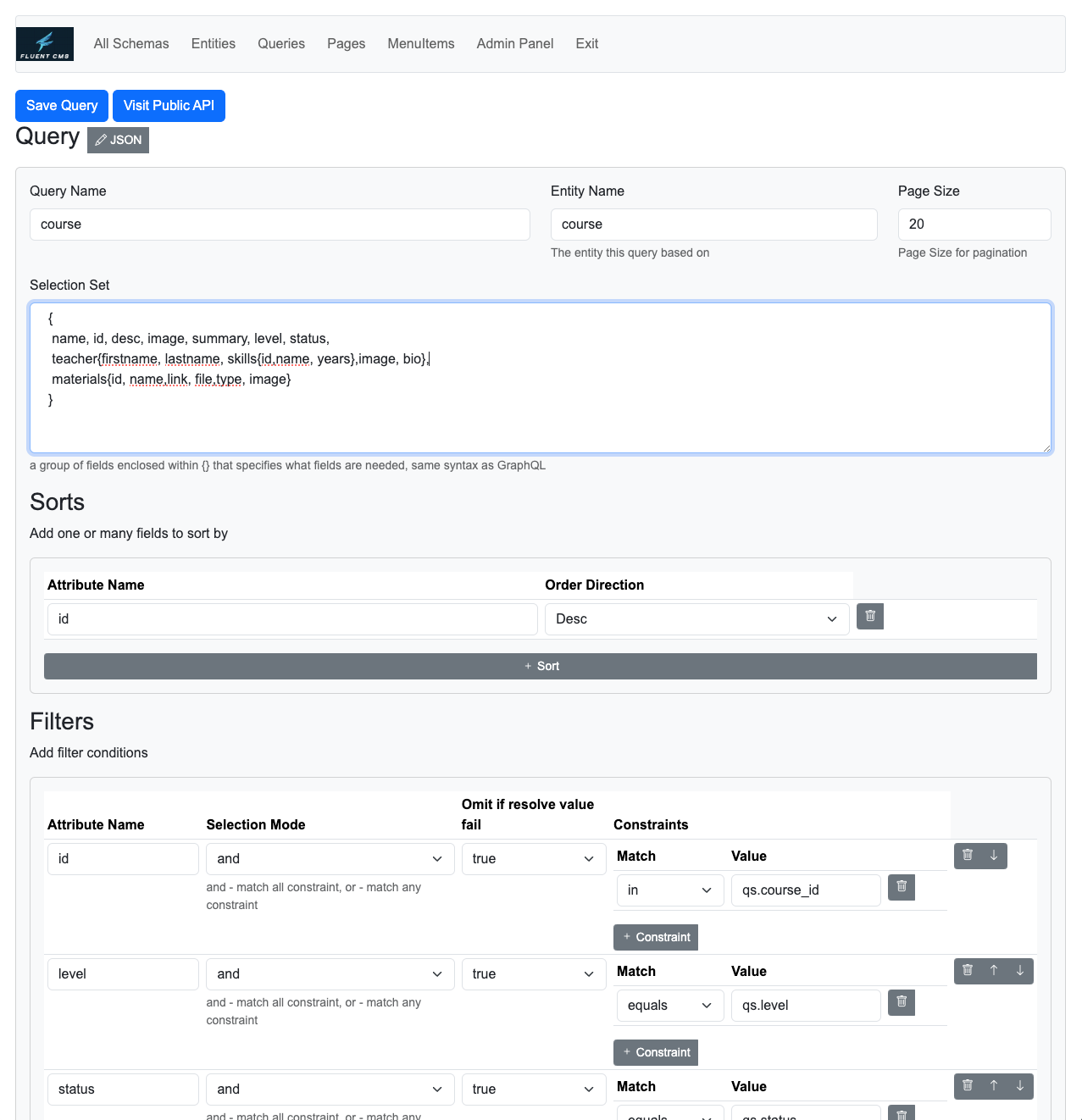
Query Structure
To understand the structure of a FluentCMS query, consider the SQL generated by FluentCMS below, with course as the primary entity:
teacheris a lookup attribute of the course.skillsis a cross-table attribute of teacher.
SELECT DISTINCT "courses"."name", "courses"."id", "courses"."desc", "courses"."image", "courses"."summary", "courses"."level", "courses"."status", "courses"."teacher"
from "courses"
left join "teachers" as "teacher" on "courses"."teacher" = "teacher"."id"
left join "skill_teacher" as "skills_skill_teacher" on "teacher"."id" = "teacher_skills_skill_teacher"."teacher_id"
left join "skills" as "teacher_skills" on "teacher_skills_skill_teacher"."skill_id" = "teacher_skills"."id"
WHERE "courses"."deleted" = 0 AND "teacher"."deleted" = 0 AND "teacher_skills_skill_teacher"."deleted" = 0 AND "teacher_skills"."deleted" = 0
AND ("teacher_skills"."id" IN (1))
ORDER BY "courses"."id"
DESC LIMIT 20
1. Selection Set
The Selection Set specifies which columns to retrieve. You can include columns from the main entity as well as lookup and crosstable entities.
{
id,
name,
desc,
image,
level,
status,
teacher{
firstname,
lastname,
image,
bio,
skills{
name,
years
}
},
materials{
name,
image,
link
}
}
2. From Entity
Each query is based on a main Entity, setting the main entity's table name as From clause.
3. Limit
The query's Page Size property sets to Limit clause.
4. Sorts
Sorts define the order by clause. Sorting can be applied to the main entity or related entities, e.g., below settings corresponds to:
select * from course left join teachers
on course.teacher = teachers.id
order by teacher.firstname asc, course.id desc
{
"sorts": [
{
"fieldName": "teacher.firstname",
"order": "Asc"
},
{
"fieldName": "id",
"order": "Desc"
}
]
}
5. Filter
Filter settings define the WHERE clause to control which data is retrieved.
- fieldName: Specifies a column in either the main entity or a related entity.
- operator:
andrequires all constraints to match, whileormatches any single constraint. - constraints:
- match: Defines how to match values, such as
inorstartWith. - value: Can be hardcoded within the query or passed as a query string parameter.
For example,qs.course_idpulls the ID from the query string parametercourse_id, where the prefixqs.indicates that the value comes from the query string.
Example API call:/api/queries/<query-name>/one?course_id=3
SQL equivalent:SELECT * FROM courses WHERE id = 3
- match: Defines how to match values, such as
- omitFail: If the query string does not contain a specific constraint value, this option omits the filter. In the example below, if
skill_idandmaterial_idare not provided, FluentCMS ignores these filters.
{
"filters": [
{
"fieldName": "id",
"operator": "and",
"omitFail": true,
"constraints": [
{
"match": "in",
"value": "qs.course_id"
}
]
},
{
"fieldName": "materials.id",
"operator": "and",
"omitFail": true,
"constraints": [
{
"match": "in",
"value": "qs.material_id"
}
]
},
{
"fieldName": "teacher.skills.id",
"operator": "and",
"omitFail": true,
"constraints": [
{
"match": "in",
"value": "qs.skill_id"
}
]
}
]
}
6. Join
When sorting or filtering by related entities, FluentCMS joins the relevant tables. For example, with course as the main entity and a filter like teacher.skills.id, FluentCMS will join these tables:
FROM "courses"
LEFT JOIN "teachers" AS "teacher" ON "courses"."teacher" = "teacher"."id"
LEFT JOIN "skill_teacher" AS "skills_skill_teacher" ON "teacher"."id" = "teacher_skills_skill_teacher"."teacher_id"
LEFT JOIN "skills" AS "teacher_skills" ON "teacher_skills_skill_teacher"."skill_id" = "teacher_skills"."id"
Subfield
Subfields in GraphQL are useful for querying complex data structures and handling relationships between entities. For example, when querying for a list of courses, each course could include a nested teacher object. Within the teacher, additional subfields like firstname, lastname, and bio can be queried. Each level of nesting defines a new layer of subfields.
{
id
name
teacher {
firstname
lastname
bio
skills {
name
years
}
}
}
With FluentCMS, you can add filter, sort, offset, and limit options to subfields, allowing for even more control over returned data.
Filter in Subfields
Filtering can be specified in three forms:
fieldName:valueformatfirstname lastname skills(years: 3) { name years }Here, the argument
years: 3for theskillssubfield generates a query with aWHEREclause equivalent toyears = 3.fieldName: { match: value }formatfirstname lastname skills(years: { gt: 3 }) { name years }Using
years: { gt: 3 }as an argument for theskillssubfield generates aWHEREclauseyears > 3.Advanced filter with multiple conditions
firstname lastname skills(years: { equals: 3, equals: 4, operator: or }) { name years }With
years: { equals: 3, equals: 4, operator: or }, the query service generates aWHEREclauseyears = 3 OR years = 4.
Sort in subfields
Sort arguments can be provided in two forms:
Simple sort by field
firstname lastname skills(years: 3, sort: years) { name years }With
sort: years, the query service generates anORDER BYclause likeORDER BY years.Sort by multiple fields and directions
firstname lastname skills(years: 3, sort: { years: desc, name: asc }) { name years }Here,
sort: { years: desc, name: asc }generates anORDER BYclauseORDER BY years DESC, name ASC.
Offset and Limit in subfields
offset and limit can be passed as query string parameters to control pagination. For instance, calling /api/queries/teacher might return a set of results:
[
{
"id": 3,
"firstname": "Jane",
"lastname": "Debuggins",
"skills": [
{
"id": 13,
"name": "Html",
"years": 7,
"teacher_id": 3,
"cursor": "eyJ5ZWFycyI6NywiaWQiOjEzLCJzb3VyY2VJZCI6M30"
},
{
"id": 2,
"name": "C#",
"years": 5,
"teacher_id": 3,
"cursor": null
},
{
"id": 15,
"name": "Database",
"years": 4,
"teacher_id": 3,
"cursor": null
},
{
"id": 1,
"name": "C++",
"years": 3,
"teacher_id": 3,
"cursor": "eyJ5ZWFycyI6MywiaWQiOjEsInNvdXJjZUlkIjozfQ"
}
],
"hasPreviousPage": false,
"cursor": "eyJpZCI6M30"
}
]
Calling /api/queries/teacher?skills.limit=2&skills.offset=1 retrieves the second and third skills in the list:
[
{
"id": 3,
"firstname": "Jane",
"lastname": "Debuggins",
"skills": [
{
"id": 2,
"name": "C#",
"years": 5,
"teacher_id": 3,
"hasPreviousPage": false,
"cursor": "eyJ5ZWFycyI6NSwiaWQiOjIsInNvdXJjZUlkIjozfQ"
},
{
"id": 15,
"name": "Database",
"years": 4,
"teacher_id": 3,
"hasNextPage": true,
"cursor": "eyJ5ZWFycyI6NCwiaWQiOjE1LCJzb3VyY2VJZCI6M30"
}
],
"hasPreviousPage": false,
"cursor": "eyJpZCI6M30"
}
]
Paginating subfields
Calling /api/queries/teacher/part/skills?last=<cursor> retrieves the records after the third skill.
[
{
"id": 15,
"name": "Database",
"years": 4,
"teacher_id": 3,
"hasPreviousPage": true,
"cursor": "eyJ5ZWFycyI6NCwiaWQiOjE1LCJzb3VyY2VJZCI6M30"
},
{
"id": 1,
"name": "C++",
"years": 3,
"teacher_id": 3,
"hasNextPage": false,
"cursor": "eyJ5ZWFycyI6MywiaWQiOjEsInNvdXJjZUlkIjozfQ"
}
]
This setup allows precise control over filtering, sorting, and paginating nested data in FluentCMS.
Query Endpoints
Each query has three corresponding endpoints:
- List:
/api/queries/<query-name>retrieves a paginated list. The example response is, if this page has previous page, thehasPreviousPageis set to ture. if the page has next page, thehasNextPageis set to true.
[
{
"name": "The Art of Pizza Making",
"id": 23,
"hasPreviousPage": false,
"cursor": "eyJpZCI6MjJ9"
},
{
"name": "Functional Programming",
"id": 22
},
{
"id": 21,
"name": "Functional Programming",
"hasPreviousPage": true,
"cursor": "eyJpZCI6M30"
}
]
The cursor field value of the two edge items is used to fetch the next or previous page.
- To view the next page:
/api/queries/<query-name>?last=<cursor> - To view the previous page:
/api/queries/<query-name>?first=<cursor>
sorts was applied when retrieving next page or previous page.
Single Record:
/api/queries/<query-name>/onereturns the first record.- Example:
/api/queries/<query-name>/one?id=***
- Example:
Multiple Records:
/api/queries/<query-name>/manyreturns multiple records.- Example:
/api/queries/<query-name>/many?id=1&id=2&id=3
- Example:
If the number of IDs exceeds the page size, only the first set will be returned.
</details>
Designing Web Page in FluentCMS
<details> <summary> The page designer utilizes the open-source GrapesJS and Handlebars, enabling seamless binding of GrapesJS Components with FluentCMS Queries for dynamic content rendering. </summary>
Introduction to GrapesJS Panels
The GrapesJS Page Designer UI provides a toolbox with four main panels:

- Style Manager: Lets users customize CSS properties of selected elements on the canvas. FluentCMS does not modify this panel.
- Traits Panel: Allows you to modify attributes of selected elements. FluentCMS adds custom traits to bind data to components here.
- Layers Panel: Displays a hierarchical view of page elements similar to the DOM structure. FluentCMS does not customize this panel, but it’s useful for locating FluentCMS blocks.
- Blocks Panel: Contains pre-made blocks or components for drag-and-drop functionality. FluentCMS adds its own customized blocks here.
Tailwind CSS Support
FluentCMS includes Tailwind CSS by default for page rendering, using the following styles:
<link rel="stylesheet" href="https://unpkg.com/tailwindcss@1.4.6/dist/base.min.css">
<link rel="stylesheet" href="https://unpkg.com/tailwindcss@1.4.6/dist/components.min.css">
<link rel="stylesheet" href="https://unpkg.com/@tailwindcss/typography@0.1.2/dist/typography.min.css">
<link rel="stylesheet" href="https://unpkg.com/tailwindcss@1.4.6/dist/utilities.min.css">
Page Types: Landing Page, Detail Page, and Home Page
Landing Page: A landing page is typically the first page a visitor sees.
The URL format is /page/<pagename>.
A landing page is typically composed of multiple Multiple Records Components, each with its own Query, making the page-level Query optional.

Detail Page: A detail page provides specific information about an item.
The URL format is /page/<pagename>/<router parameter>, FluentCMS retrieves data by passing the router parameter to the FluentCMS Query.
For the following settings
- Page Name:
course/{id} - Query:
courses
FluentCMS will call the queryhttps://fluent-cms-admin.azurewebsites.net/api/queries/courses/one?id=3for URLhttps://fluent-cms-admin.azurewebsites.net/pages/course/3

Home Page:
The homepage is a special landing page with the name home. Its URL is /pages/home. If no other route handles the path /, FluentCMS will render / as /pages/home.
Data Binding: Singleton or Multiple Records
FluentCMS uses Handlebars expression for dynamic data binding.
Singleton
Singleton fields are enclosed within {{ }}.
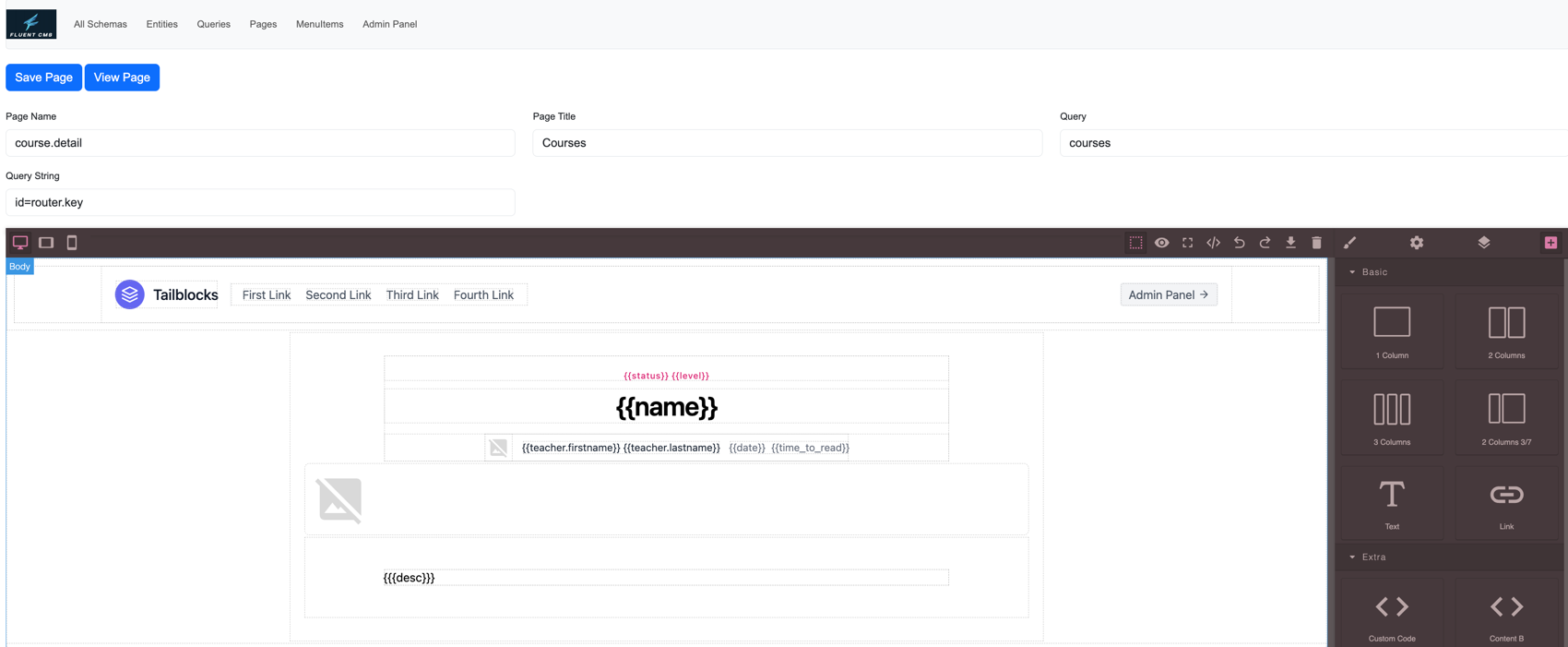
Multiple Records
Handlebars loops over arrays using the each block.
{{#each course}}
<li>{{title}}</li>
{{/each}}
However, you won’t see the {{#each}} statement in the GrapesJS Page Designer. FluentCMS adds it automatically for any block under the Multiple Records category.
Steps to bind multiple records:
- Drag a block from the
Multiple Recordscategory.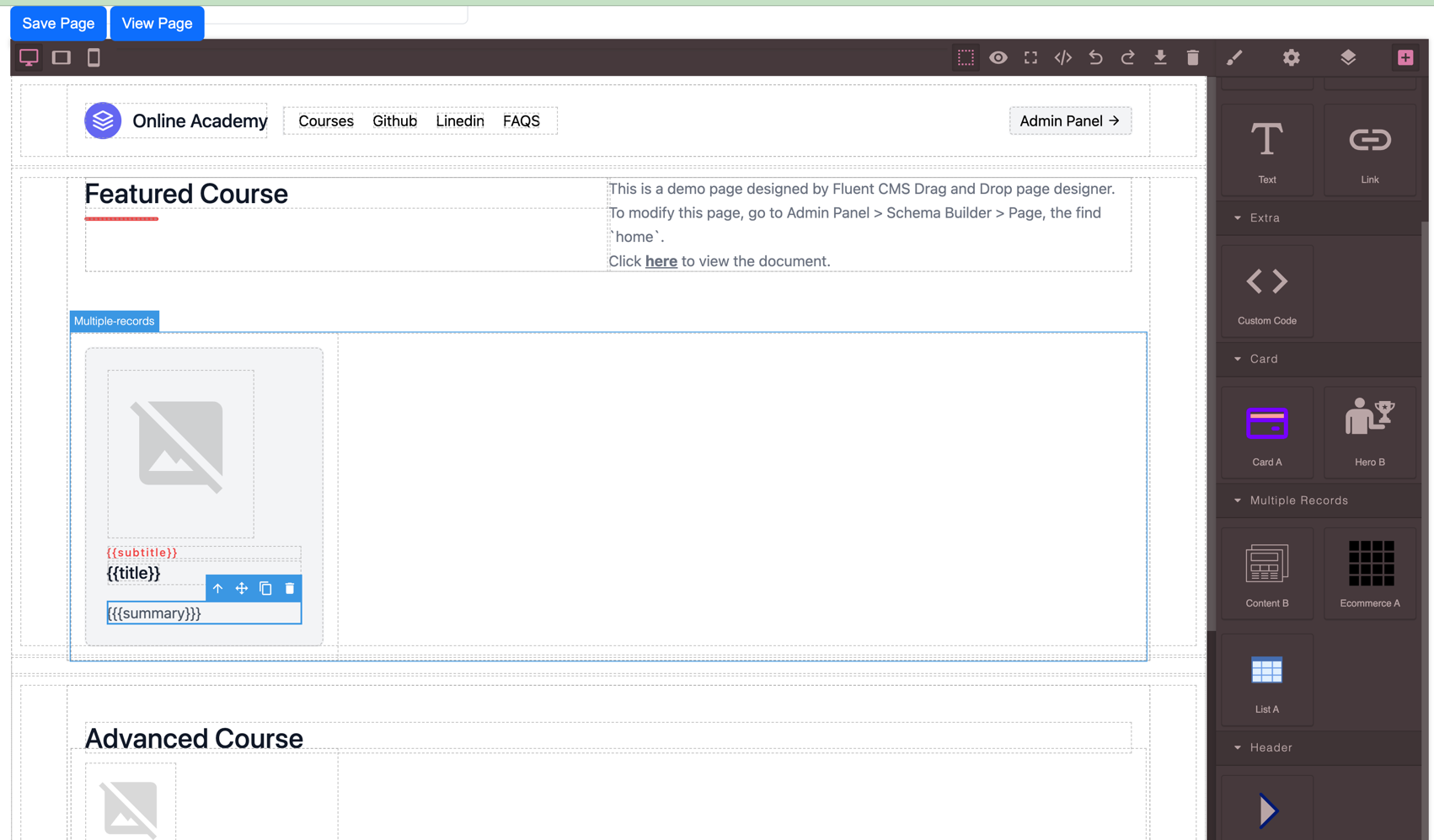
- Hover over the GrapesJS components to find a block with the
Multiple-recordstag in the top-left corner, then click theTraitspanel. You can also use the GrapesJS Layers Panel to locate the component.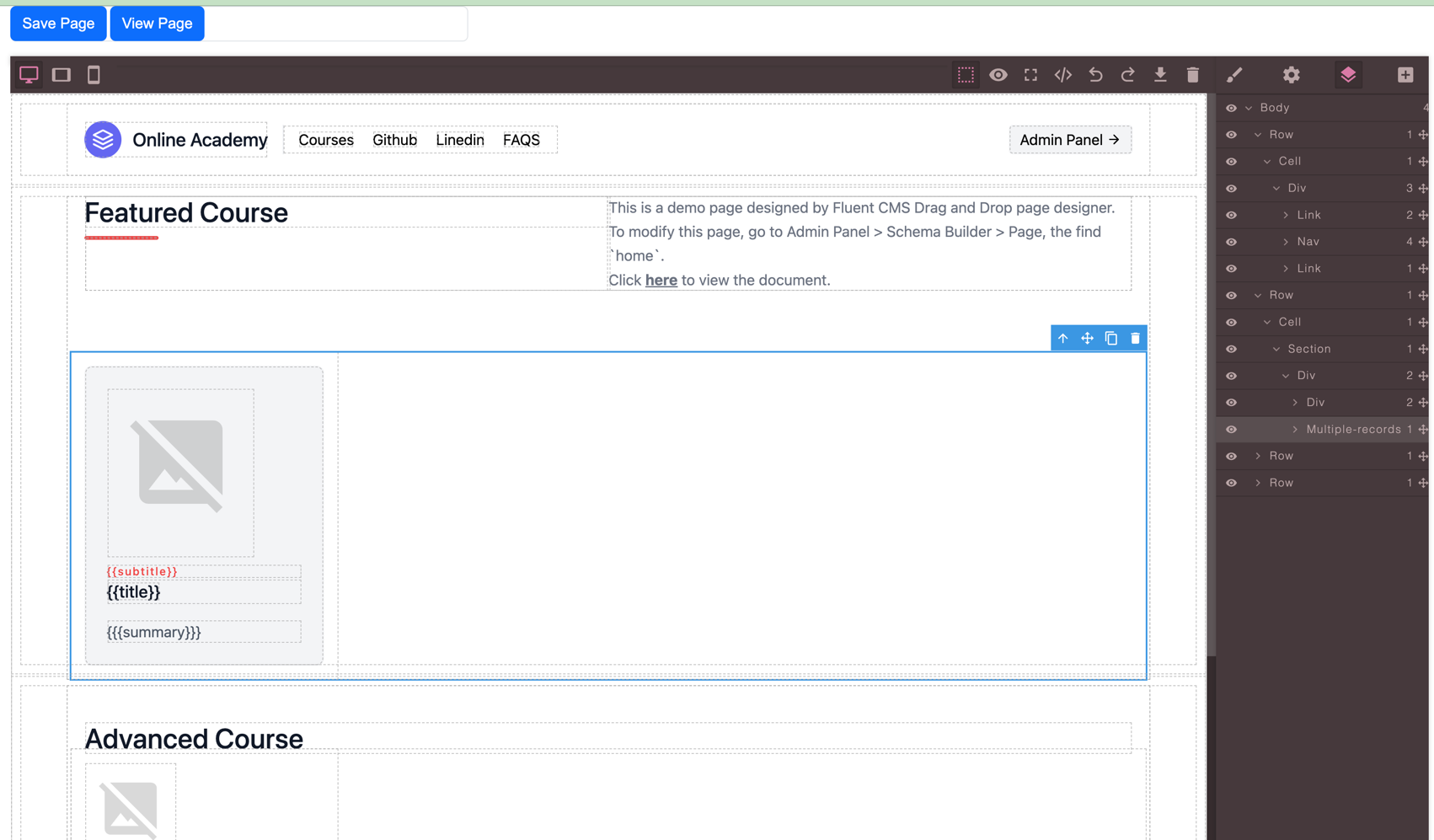
- In the
Traitspanel, you have the following options:- Field: Specify the field name for the Page-Level Query (e.g., for the FluentCMS Query below, you could set the field as
teacher.skills).{ "teacher": { "firstname": "", "skills": [ { "name": "cooking fish", "years": 3 } ] } } - Query: The query to retrieve data.
- Qs: Query string parameters to pass (e.g.,
?status=featured,?level=Advanced). - Offset: Number of records to skip.
- Limit: Number of records to retrieve.
- Pagination There are 3 Options:
Button, content is divided into multiple pages, and navigation buttons (e.g., "Next," "Previous," or numbered buttons) are provided to allow users to move between the pages.Infinite Scroll, Content automatically loads as the user scrolls down the page, providing a seamless browsing experience without manual page transitions. It's better to set only one component toinfinite scroll, and put it to the bottom of the pages.None. Users see all the available content at once, without the need for additional actions.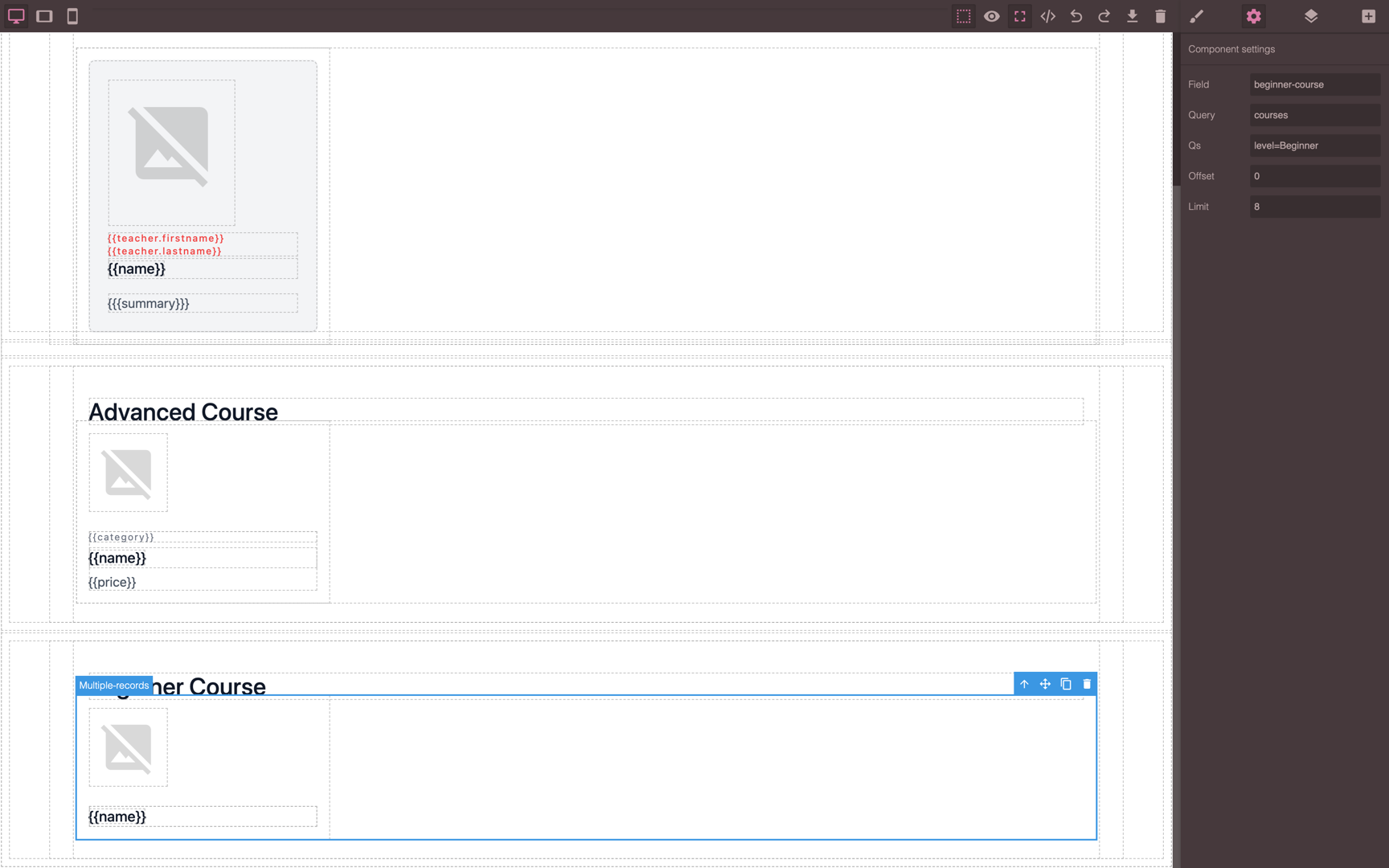
- Field: Specify the field name for the Page-Level Query (e.g., for the FluentCMS Query below, you could set the field as
Linking and Images
FluentCMS does not customize GrapesJS' Image and Link components, but locating where to input Query Field can be challenging. The steps below explain how to bind them.
Link: Locate the link by hovering over the GrapesJS component or finding it in the
GrapesJS Layers Panel. Then switch to theTraits Paneland input the detail page link, e.g.,/pages/course/{{id}}. FluentCMS will render this as<a href="/pages/course/3">...</a>.Image: Double-click on the image component, input the image path, and select the image. For example, if the image field is
thumbnail_image_url, input/files/{{thumbnail_image_url}}. FluentCMS will replace{{thumbnail_image_url}}with the actual field value.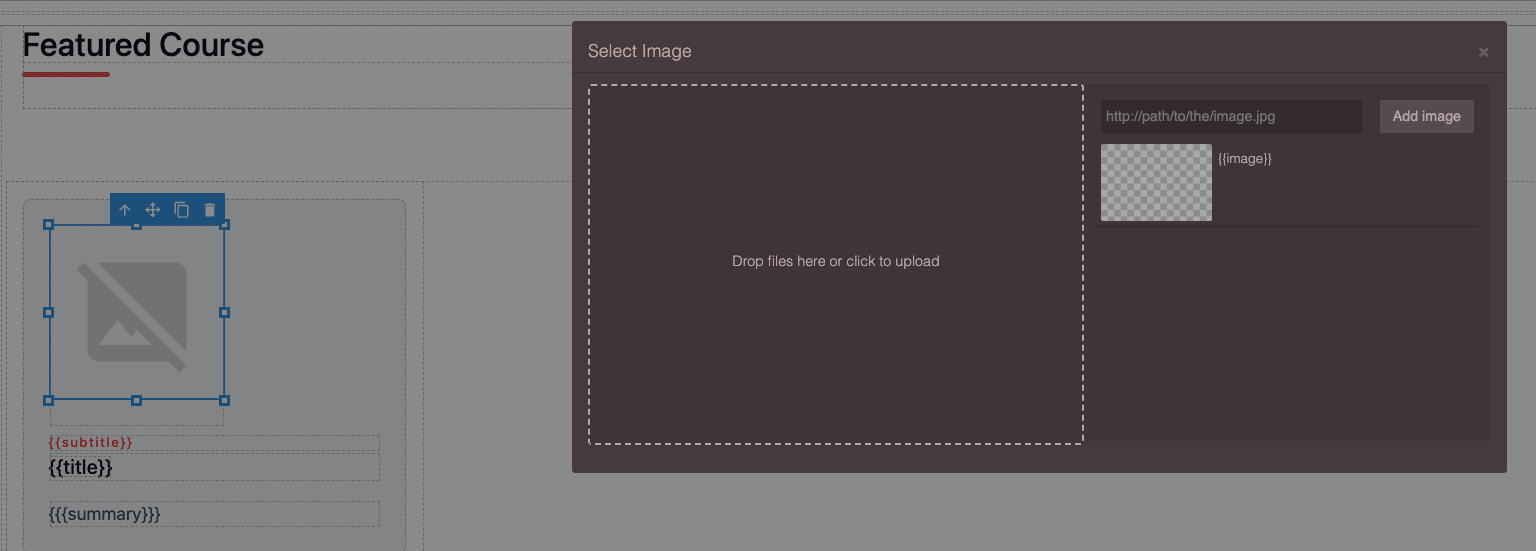
Customized Blocks
FluentCMS adds customized blocks to simplify web page design and data binding for FluentCMS Queries. These blocks use Tailwind CSS.
- Multiple Records: Components in this category contain subcomponents with a
Multiple-Recordstrait. - Card: Typically used in detail pages.
- Header: Represents a navigation bar or page header. </details>
Developing Frontend of a online course website
<details> <summary> Having established our understanding of Fluent CMS essentials like Entity Schemas, GraphQL-style Querying, and GrapeJS-based Page Design, we’re ready to build a frontend for an online course website. </summary>
Introduction of online course website
The online course website is designed to help users easily find courses tailored to their interests and goals.
Home Page(
home): This is the main entry point, providingFeatured Course,Advanced Course, etc. Each course in these sections links to its Course Details page.Latest Courses(
course): A curated list of the newest courses. Each course in this section links to its Course Details page.Course Details(
course/{course_id}): This page provides a comprehensive view of a selected course. Users can navigate to the Teacher Details page to learn more about the instructor.Teacher Details(
teacher/{teacher_id}): Here, users can explore the profile of the instructor, This page contains ateacher's latest course section, each course in the sections links back to Course Details
Home Page
|
|
+-------------------+
| |
v v
Latest Courses Course Details
| |
| |
v v
Course Details <-------> Teacher Details
Designing the Home Page
The home page's screenshot shows below.
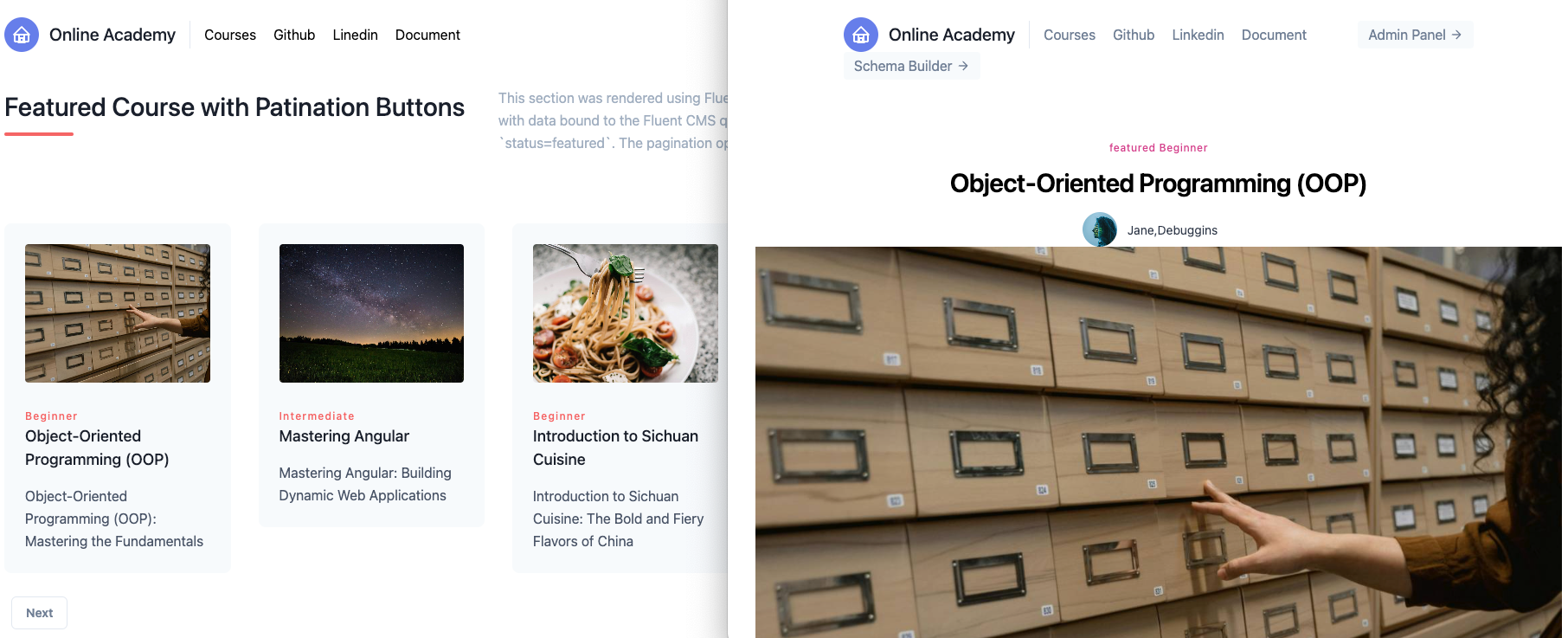
In the page designer, we drag a component Content-B, set it's multiple-records component's data source to Query course.
The query might return data like
[
{
"name": "Object-Oriented Programming(OOP)",
"id": 20,
"teacher":{
"id": 3,
"firstname": "jane"
}
}
]
We set link href of each course item to /pages/course/{{id}}.

HandleBar rendering engine renders the link as /pages/course/20 by replacing {{id}} to 20.
Creating Course Detail Page
We name this page course/{course_id} to capture the path parameter course_id.
For example, with the URL /pages/course/20, we obtain {course_id: 20}. This parameter is passed to the Query Service, which then filters data to match:
{
"fieldName": "id",
"operator": "and",
"omitFail": true,
"constraints": [
{
"match": "in",
"value": "qs.course_id"
}
]
}
The query service produces a where clause as where id in (20).
Link to Teacher Detail Page
We set the link of each teacher item as /pages/teacher/{{teacher.id}}, allowing navigation from Course Details to Teacher Details:
For below example data, HandlerBar render the link as /pages/teacher/3.
[
{
"name": "Object-Oriented Programming(OOP)",
"id": 20,
"teacher":{
"id": 3,
"firstname": "jane"
}
}
]
Creating Teacher's Detail Page
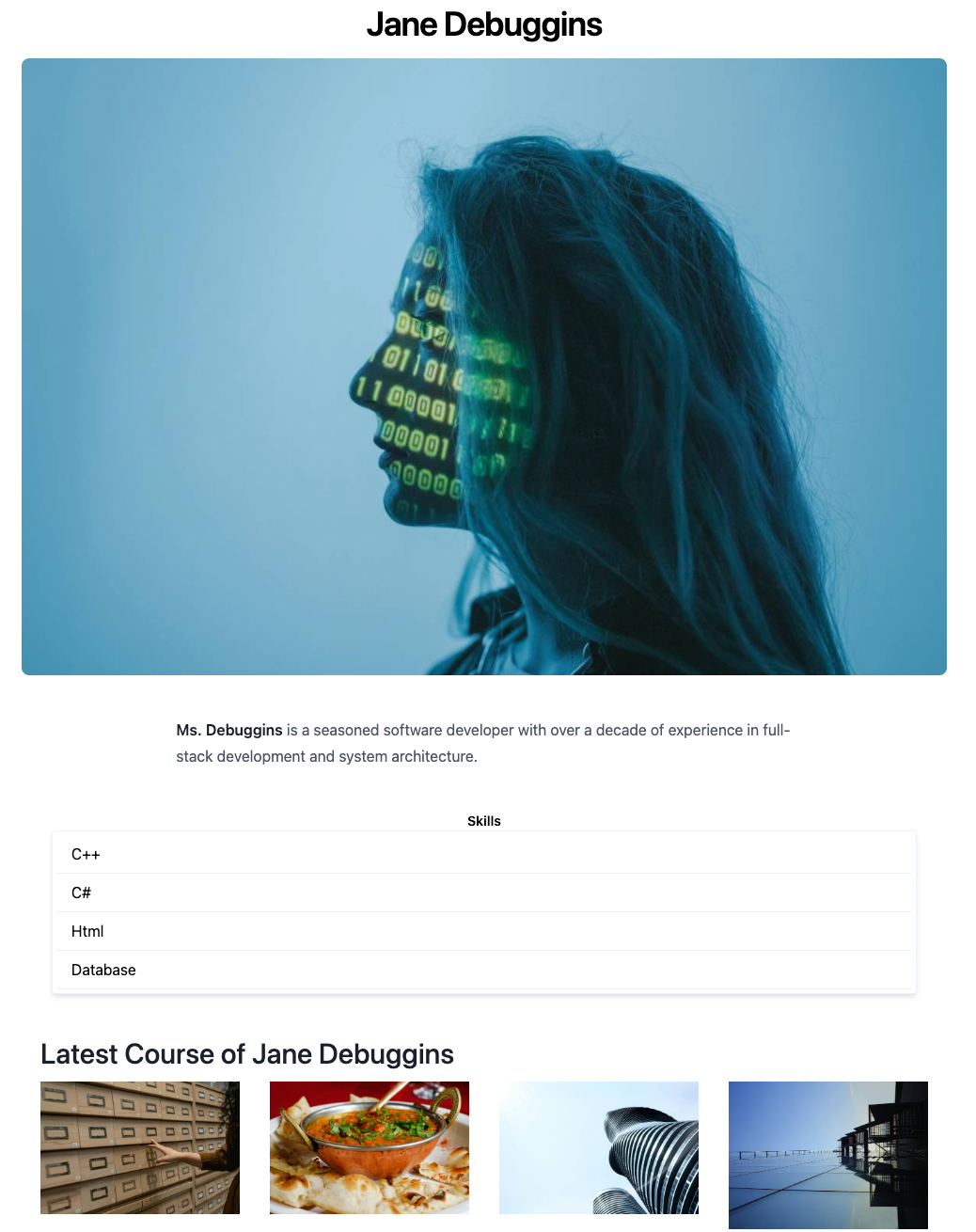
Similarly, we name this page as teacher/{teacher_id} and set its data source Query to teacher. For the URL /pages/teacher/3, the query returns:
{
"id": 3,
"firstname": "Jane",
"lastname": "Debuggins",
"image": "/2024-10/b44dcb4c.jpg",
"bio": "<p><strong>Ms. Debuggins</strong> is a seasoned software developer with over a decade of experience in full-stack development and system architecture. </p>",
"skills": [
{
"id": 1,
"name": "C++",
"years": 3,
"teacher_id": 3
}
]
}
To add a list of courses by the teacher, we set a multiple-records component with Query course.
 When rendering the Teacher Page, PageService sends
When rendering the Teacher Page, PageService sends {teacher_id: 3} to Query course.
The QueryService Apply below filter, resulting in WHERE teacher in (3).
{
"fieldName": "teacher",
"operator": "and",
"omitFail": true,
"constraints": [
{
"match": "in",
"value": "qs.teacher_id"
}
]
}
This design creates an interconnected online course site, ensuring users can explore course details, instructors. </details>
Development Guide
<details><summary>The backend is written in ASP.NET Core, the Admin Panel uses React, and the Schema Builder is developed with jQuery</summary>
System Overviews

Backend Server
- Tools:
- ASP.NET Core
- SqlKata: SqlKata

Admin Panel UI
- Tools:
- React
- PrimeReact: PrimeReact UI Library
- SWR: Data Fetching/State Management

Schema Builder UI
- Tools:
- jsoneditor: JSON Editor
 </details>
</details>
Testing
<details><summary>This chapter describes Fluent CMS's automated testing strategy</summary>
Fluent CMS favors integration testing over unit testing because integration tests can catch more real-world issues. For example, when inserting a record into the database, multiple modules are involved:
EntitiesControllerEntitiesServiceEntity(in the query builder)- Query executors (e.g.,
SqlLite,Postgres,SqlServer)
Writing unit tests for each individual function and mocking its upstream and downstream services can be tedious. Instead, Fluent CMS focuses on checking the input and output of RESTful API endpoints in its integration tests.
However, certain cases, such as the Hook Registry or application bootstrap, are simpler to cover with unit tests.
Unit Testing /fluent-cms/server/FluentCMS.Test
This project focuses on testing specific modules, such as:
- Hook Registry
- Application Bootstrap
Integration Testing for FluentCMS.Blog /fluent-cms/server/FluentCMS.Blog.Tests
This project focuses on verifying the functionalities of the FluentCMS.Blog example project.
New Feature Testing /fluent-cms/server/FluentCMS.App.Tests
This project is dedicated to testing experimental functionalities, like MongoDB and Kafka plugins.
</details>
| Product | Versions Compatible and additional computed target framework versions. |
|---|---|
| .NET | net8.0 is compatible. net8.0-android was computed. net8.0-browser was computed. net8.0-ios was computed. net8.0-maccatalyst was computed. net8.0-macos was computed. net8.0-tvos was computed. net8.0-windows was computed. net9.0 was computed. net9.0-android was computed. net9.0-browser was computed. net9.0-ios was computed. net9.0-maccatalyst was computed. net9.0-macos was computed. net9.0-tvos was computed. net9.0-windows was computed. |
-
net8.0
- AutoMapper (>= 13.0.1)
- Confluent.Kafka (>= 2.5.2)
- DynamicExpresso.Core (>= 2.16.1)
- FluentMigrator.Runner.Postgres (>= 5.2.0)
- FluentMigrator.Runner.Sqlite (>= 5.2.0)
- FluentResults (>= 3.16.0)
- GraphQL-Parser (>= 9.5.0)
- Handlebars.Net (>= 2.1.6)
- HtmlAgilityPack (>= 1.11.65)
- Microsoft.AspNetCore.Identity.EntityFrameworkCore (>= 8.0.8)
- Microsoft.AspNetCore.Mvc.Testing (>= 8.0.7)
- Microsoft.AspNetCore.OpenApi (>= 8.0.6)
- Microsoft.AspNetCore.WebUtilities (>= 8.0.6)
- Microsoft.EntityFrameworkCore.Sqlite (>= 8.0.6)
- Microsoft.EntityFrameworkCore.SqlServer (>= 8.0.7)
- MongoDB.Driver (>= 2.28.0)
- Npgsql.EntityFrameworkCore.PostgreSQL (>= 8.0.4)
- SkiaSharp (>= 2.88.8)
- SqlKata (>= 2.4.0)
- SqlKata.Execution (>= 2.4.0)
- Swashbuckle.AspNetCore (>= 6.4.0)
- System.Data.SqlClient (>= 4.8.6)
- System.Runtime.Caching (>= 8.0.1)
- xunit.assert (>= 2.5.3)
NuGet packages
This package is not used by any NuGet packages.
GitHub repositories
This package is not used by any popular GitHub repositories.
| Version | Downloads | Last updated |
|---|---|---|
| 0.3.4 | 57 | 1/7/2025 |
| 0.3.3 | 75 | 1/3/2025 |
| 0.3.2 | 57 | 12/23/2024 |
| 0.3.1 | 58 | 12/17/2024 |
| 0.3.0.2 | 53 | 12/12/2024 |
| 0.3.0.1 | 55 | 12/12/2024 |
| 0.3.0 | 61 | 12/11/2024 |
| 0.2.8.1 | 94 | 11/29/2024 |
| 0.2.8 | 87 | 11/29/2024 |
| 0.2.7 | 92 | 11/29/2024 |
| 0.2.6 | 103 | 11/11/2024 |
| 0.2.5 | 103 | 10/30/2024 |
| 0.2.4 | 110 | 10/23/2024 |
| 0.2.3 | 123 | 10/2/2024 |
| 0.2.2 | 110 | 10/2/2024 |
| 0.2.1 | 115 | 9/26/2024 |
| 0.2.0 | 111 | 9/8/2024 |
| 0.1.8 | 111 | 9/8/2024 |
| 0.1.7 | 103 | 9/8/2024 |
| 0.1.6 | 117 | 9/8/2024 |
| 0.1.5 | 111 | 9/8/2024 |
| 0.1.4 | 124 | 8/30/2024 |
| 0.1.3 | 144 | 8/23/2024 |
| 0.1.2 | 128 | 8/23/2024 |
| 0.1.1 | 138 | 8/22/2024 |
| 0.1.0 | 139 | 8/22/2024 |
| 0.0.6 | 144 | 8/15/2024 |
| 0.0.5 | 128 | 8/15/2024 |
| 0.0.4 | 94 | 8/5/2024 |
| 0.0.3 | 159 | 7/31/2024 |
